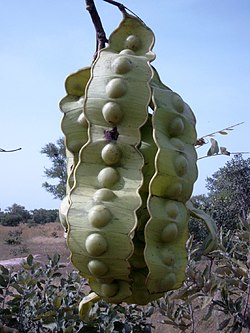| Entada | |
|---|---|
 | |
| Entada africana fruit | |
| Scientific classification | |
| Kingdom: | Plantae |
| Clade: | Tracheophytes |
| Clade: | Angiosperms |
| Clade: | Eudicots |
| Clade: | Rosids |
| Order: | Fabales |
| Family: | Fabaceae |
| Subfamily: | Caesalpinioideae |
| Clade: | Mimosoid clade |
| Genus: | Entada Adans. (1763) [1] |
| Species | |
See text | |
| Synonyms [2] | |
| |



Entada is a genus of flowering plants in the family Fabaceae, in the mimosoid clade of the subfamily Caesalpinioideae. [3] It consists of some 30 species of trees, shrubs and tropical lianas. About 21 species are known from Africa, six from Asia, two from the American tropics and one with a pantropical distribution. They have compound leaves and produce exceptionally large seedpods of up to 1.5 metres (4.9 ft) long. Their seeds are buoyant and survive lengthy journeys via rivers and ocean currents, to eventually wash up on tropical beaches. According to Menninger the liana species of Entada can grow up to 30 m (98 ft) longer in eighteen months. [4] According to Dr. Bruno Kremer of the University of Cologne, Entada spp. "beats all records for longitudinal growth" reaching lengths "between 300 and 400 metres (980 and 1,310 ft)". [5]